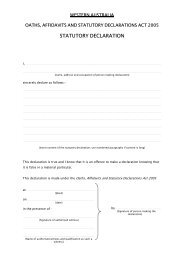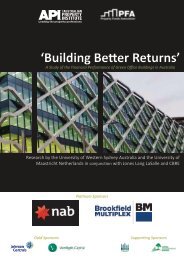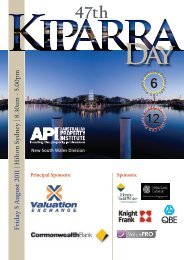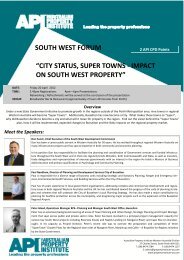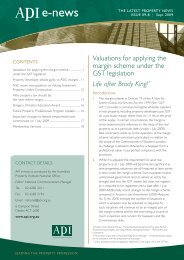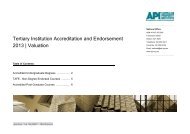VALUATIONS FOR INSURANCE PURPOSES
VALUATIONS FOR INSURANCE PURPOSES
VALUATIONS FOR INSURANCE PURPOSES
You also want an ePaper? Increase the reach of your titles
YUMPU automatically turns print PDFs into web optimized ePapers that Google loves.
ANZ VALUATION GUIDANCE NOTE 13<br />
the actual insurance policy.<br />
When considering the terms and conditions of the<br />
actual insurance policy it may be prudent for the<br />
member to obtain legal advice as to the operation<br />
of particular clauses within the policy.<br />
4.0 Assessing Reinstatement<br />
Cost<br />
Reinstatement cost is sometimes referred to as the cost of<br />
reinstating an asset to an as new condition or new for old.<br />
The reinstatement cost notionally assumes a total loss.<br />
In the case of a partial loss, reinstatement cost also covers<br />
the cost of repairing the property insured to its condition<br />
when new. The extent of damage and therefore the cost<br />
of repairs cannot be anticipated prior to an actual loss<br />
occurring. The cost of repairs may be more or less than<br />
the reinstatement cost of the property insured.<br />
To the extent the estimated cost of repairs is greater than<br />
the estimated cost to completely replace or reinstate<br />
the property insured, it is to be assumed that the insurer<br />
would seek to completely replace or reinstate rather than<br />
repair the property insured. In any case, the assessment of<br />
repair costs is typically within the area of expertise of a loss<br />
adjustor or loss assessor and can only be completed after a<br />
loss has occurred.<br />
It can be seen therefore, that seeking to estimate the costs<br />
of repair is neither possible nor relevant when completing<br />
valuations for the purpose of setting the amount of cover.<br />
In completing valuations on the basis of reinstatement cost<br />
a valuer should consider the items below.<br />
4.1 Reinstatement Cost Estimates<br />
There are a number of ways of providing an<br />
estimate of reinstatement cost for buildings,<br />
structures and site improvements. Two of the<br />
more common approaches are:<br />
• an estimate based on building cost guides; and<br />
• an estimate based on elemental costs.<br />
In the former the estimate of reinstatement cost<br />
is based on construction cost rates (typically, but<br />
not always, rates per square metre) published in<br />
building cost guides and/or construction contract<br />
rates. This commonly used method is intended to<br />
provide indicative cost estimates.<br />
Elemental building cost estimates determine the<br />
construction cost of a building, structure or site<br />
improvement by reference to the estimated cost<br />
of the individual components or elements of that<br />
building, structure or site improvement. The<br />
application of such an approach requires specific<br />
training and knowledge.<br />
Members who are qualified to complete elemental<br />
cost estimates typically obtain detailed building<br />
plans and specifications or gather such information<br />
from a physical inspection of the site to assist<br />
in the accuracy of the determination. Where<br />
information is available, recent constructions<br />
of a similar nature may assist to determine the<br />
appropriate cost for each element. Consideration<br />
should be given to the reliability of evidence<br />
available and the information assessed in terms of<br />
comparability to the subject asset.<br />
All other things being equal an elemental cost<br />
estimate is likely to produce a more robust cost<br />
estimate than an estimate based on building cost<br />
guides as is evidenced by the statement that the<br />
latter is intended to provide an indicative cost<br />
estimate.<br />
In applying the selected method(s), Members<br />
should have regard to the following factors (if<br />
quantifiable):<br />
• Specific materials used in the building (e.g.<br />
mixture of stone, brick, plasterboard, etc.)<br />
• Location factors (e.g. remote or rural sites v<br />
metropolitan)<br />
• Design of building including soil type, special<br />
footings, etc.<br />
• External dimensions of a building (some<br />
cost guides relate only to internal building<br />
measurements)<br />
• All fees associated with reconstruction including<br />
architects, survey and engineering fees<br />
• Cost increases/decreases between the date<br />
of issue of published cost guides and / or the<br />
date of construction contracts, and the date of<br />
valuation<br />
Valuations undertaken in non-metropolitan and<br />
remote areas would usually reflect regional costs<br />
associated with labour and materials. It may<br />
be possible to estimate the location factor by<br />
investigating local construction costs and / or by<br />
examining a sample of costs and relating them to<br />
known costs.<br />
In respect of common householder policies, unless<br />
specifically excluded, the following items are<br />
required to be included in the determination of the<br />
ANZVGN 13 <strong>VALUATIONS</strong> <strong>FOR</strong> <strong>INSURANCE</strong> <strong>PURPOSES</strong><br />
8.13.5





